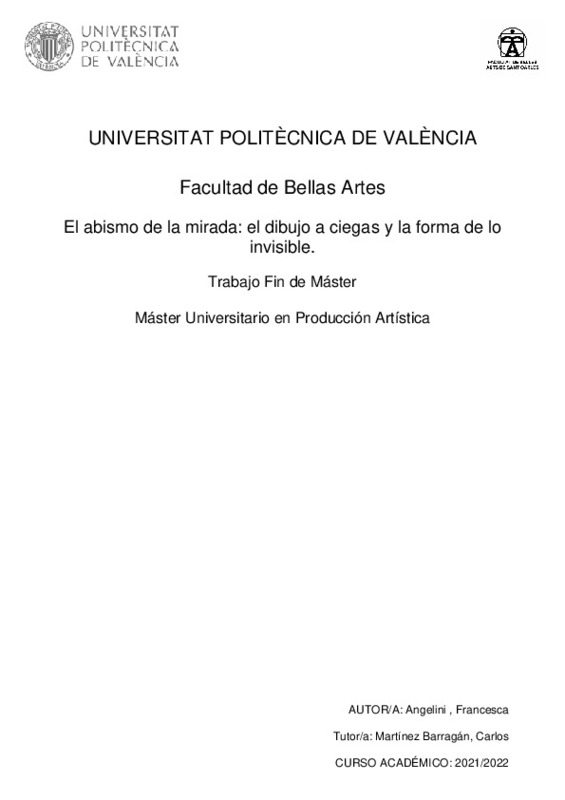|
Resumen:
|
[ES] Los ojos, el órgano de la vista, el encuentro con el otro, portal de intercambio entre lo interior y lo exterior. Si lo veo entonces existe, estamos acostumbrados a oír. Pero hay algo, sin embargo, que escapa a la ...[+]
[ES] Los ojos, el órgano de la vista, el encuentro con el otro, portal de intercambio entre lo interior y lo exterior. Si lo veo entonces existe, estamos acostumbrados a oír. Pero hay algo, sin embargo, que escapa a la mirada, hay algo que no se ve, pero que manifiesta su presencia todos los días. Lo invisible, de lo que habla Klee, de lo que habla Antoine de Saint-Exupéry. Es la sombra que pinta Butade en la pared, la forma de una presencia que es al mismo tiempo ausencia, la forma de una dimensión inscrita en la vida mnemónica. La memoria como matriz donde la imagen se acuna y se nutre. Demócrito de Abddera se arrancó los ojos porque los consideraba una distracción, para ver solo lo que hay dentro, y dentro queda un conjunto de memoria e identidad. Del mismo modo muchos artistas han tratado de "ver" lo invisible cerrando la mirada. Robert Morris, William Anastasi, Claude Heath y tantos otros, a través del dibujo a ciegas han realizado esta investigación dando vida a imagenes del sentido, formas de lo que forma no tiene. A raíz de estos, el proyecto artístico propone el desarrollo del diseño ciego como huella de lo invisible, para buscar una visión diferente, una mirada menos ciega que nunca, dirigida por la memoria y sentimiento." Que lloren estos ojos, que vean estas lágrimas", decía Andrew Marvell.
[-]
[EN] The eyes, the organ of sight, the encounter with the other, a portal of exchange between the interior and the exterior. If I see it then it exists, we are used to hear. But there is something, however, that escapes ...[+]
[EN] The eyes, the organ of sight, the encounter with the other, a portal of exchange between the interior and the exterior. If I see it then it exists, we are used to hear. But there is something, however, that escapes the gaze, there is something that can not be seen, but manifests its presence every day. The invisible that Klee talks about, the same that Antoine de Saint-Exupéry talks about. It is the shadow Butade paints on the wall, the form of a presence that is at the same time absence, the form of a dimension inscribed in mnemonic life. Memory as a matrix where the image is cradled and nourished. Democritus of Abddera gouged out his eyes because he considered them a distraction, in order to see only what is inside, and inside remains a set of memory and identity. Similarly, many artists have tried to "see" the invisible by closing their eyes. Robert Morris, William Anastasi, Claude Heath and many others, through the blind drawing, have carried out this research, giving life to images of meaning, shape of the shapeless. As a result of these, the artistic project proposes the development of blind design as a trace of the invisible, to seek a different vision, a gaze less blind than ever, directed by memory and feelings. "These weeping eyes, those seeing tears.¿ Said Andrew Marvell.
[-]
|







